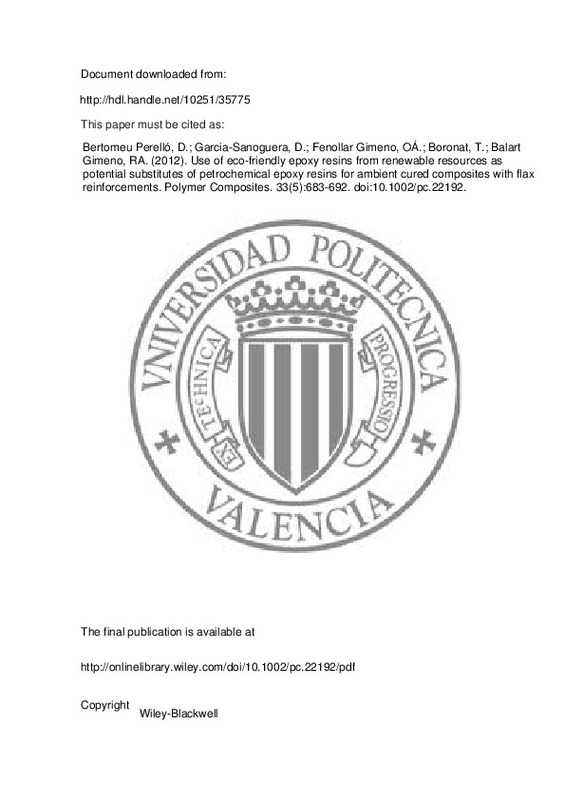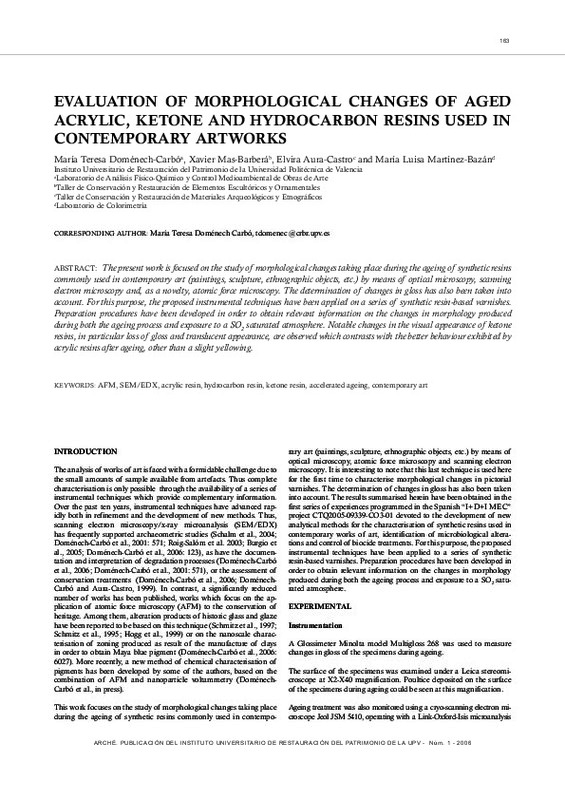Alves, C., Ferrão, P. M. C., Silva, A. J., Reis, L. G., Freitas, M., Rodrigues, L. B., & Alves, D. E. (2010). Ecodesign of automotive components making use of natural jute fiber composites. Journal of Cleaner Production, 18(4), 313-327. doi:10.1016/j.jclepro.2009.10.022
JOHN, M., & THOMAS, S. (2008). Biofibres and biocomposites. Carbohydrate Polymers, 71(3), 343-364. doi:10.1016/j.carbpol.2007.05.040
Mohanty, A. K., Misra, M., & Drzal, L. T. (2002). Journal of Polymers and the Environment, 10(1/2), 19-26. doi:10.1023/a:1021013921916
[+]
Alves, C., Ferrão, P. M. C., Silva, A. J., Reis, L. G., Freitas, M., Rodrigues, L. B., & Alves, D. E. (2010). Ecodesign of automotive components making use of natural jute fiber composites. Journal of Cleaner Production, 18(4), 313-327. doi:10.1016/j.jclepro.2009.10.022
JOHN, M., & THOMAS, S. (2008). Biofibres and biocomposites. Carbohydrate Polymers, 71(3), 343-364. doi:10.1016/j.carbpol.2007.05.040
Mohanty, A. K., Misra, M., & Drzal, L. T. (2002). Journal of Polymers and the Environment, 10(1/2), 19-26. doi:10.1023/a:1021013921916
Pillin, I., Kervoelen, A., Bourmaud, A., Goimard, J., Montrelay, N., & Baley, C. (2011). Could oleaginous flax fibers be used as reinforcement for polymers? Industrial Crops and Products, 34(3), 1556-1563. doi:10.1016/j.indcrop.2011.05.016
Summerscales, J., Dissanayake, N. P. J., Virk, A. S., & Hall, W. (2010). A review of bast fibres and their composites. Part 1 – Fibres as reinforcements. Composites Part A: Applied Science and Manufacturing, 41(10), 1329-1335. doi:10.1016/j.compositesa.2010.06.001
Sreekumar, P. A., Saiah, R., Saiter, J. M., Leblanc, N., Joseph, K., Unnikrishnan, G., & Thomas, S. (2009). Dynamic mechanical properties of sisal fiber reinforced polyester composites fabricated by resin transfer molding. Polymer Composites, 30(6), 768-775. doi:10.1002/pc.20611
Mu, Q., Wei, C., & Feng, S. (2009). Studies on mechanical properties of sisal fiber/phenol formaldehyde resin in-situ composites. Polymer Composites, 30(2), 131-137. doi:10.1002/pc.20529
Sever, K., Sarikanat, M., Seki, Y., Erkan, G., Erdoğan, Ü. H., & Erden, S. (2012). Surface treatments of jute fabric: The influence of surface characteristics on jute fabrics and mechanical properties of jute/polyester composites. Industrial Crops and Products, 35(1), 22-30. doi:10.1016/j.indcrop.2011.05.020
Wood, B. M., Coles, S. R., Maggs, S., Meredith, J., & Kirwan, K. (2011). Use of lignin as a compatibiliser in hemp/epoxy composites. Composites Science and Technology, 71(16), 1804-1810. doi:10.1016/j.compscitech.2011.06.005
Eichhorn, S. J., Baillie, C. A., Zafeiropoulos, N., Mwaikambo, L. Y., Ansell, M. P., Dufresne, A., … Wild, P. M. (2001). Journal of Materials Science, 36(9), 2107-2131. doi:10.1023/a:1017512029696
Dissanayake, N. P. J., Summerscales, J., Grove, S. M., & Singh, M. M. (2009). Life Cycle Impact Assessment of Flax Fibre for the Reinforcement of Composites. Journal of Biobased Materials and Bioenergy, 3(3), 245-248. doi:10.1166/jbmb.2009.1029
Masudul Hassan, M., & Khan, M. A. (2008). Role of N-(β-amino ethyl) γ-aminopropyl trimethoxy silane as Coupling Agent on the Jute-polycarbonate Composites. Polymer-Plastics Technology and Engineering, 47(8), 847-850. doi:10.1080/03602550802188862
Zaman, H. U., Khan, M. A., & Khan, R. A. (2009). Improvement of Mechanical Properties of Jute Fibers-Polyethylene/Polypropylene Composites: Effect of Green Dye and UV Radiation. Polymer-Plastics Technology and Engineering, 48(11), 1130-1138. doi:10.1080/03602550903147262
Zou, Y., Xu, H., & Yang, Y. (2010). Lightweight Polypropylene Composites Reinforced by Long Switchgrass Stems. Journal of Polymers and the Environment, 18(4), 464-473. doi:10.1007/s10924-010-0165-4
De Arcaya, P. A., Retegi, A., Arbelaiz, A., Kenny, J. M., & Mondragon, I. (2009). Mechanical properties of natural fibers/polyamides composites. Polymer Composites, 30(3), 257-264. doi:10.1002/pc.20558
Twite-Kabamba, E., Mechraoui, A., & Rodrigue, D. (2009). Rheological properties of polypropylene/hemp fiber composites. Polymer Composites, 30(10), 1401-1407. doi:10.1002/pc.20704
De Rosa, I. M., Iannoni, A., Kenny, J. M., Puglia, D., Santulli, C., Sarasini, F., & Terenzi, A. (2011). Poly(lactic acid)/Phormium tenax composites: Morphology and thermo-mechanical behavior. Polymer Composites, 32(9), 1362-1368. doi:10.1002/pc.21159
Christian, S. J., & Billington, S. L. (2011). Mechanical response of PHB- and cellulose acetate natural fiber-reinforced composites for construction applications. Composites Part B: Engineering, 42(7), 1920-1928. doi:10.1016/j.compositesb.2011.05.039
Hodzic, A., Coakley, R., Curro, R., Berndt, C. C., & Shanks, R. A. (2007). Design and Optimization of Biopolyester Bagasse Fiber Composites. Journal of Biobased Materials and Bioenergy, 1(1), 46-55. doi:10.1166/jbmb.2007.005
Bax, B., & Müssig, J. (2008). Impact and tensile properties of PLA/Cordenka and PLA/flax composites. Composites Science and Technology, 68(7-8), 1601-1607. doi:10.1016/j.compscitech.2008.01.004
Leite, M. C. A. M., Furtado, C. R. G., Couto, L. O., Oliveira, F. L. B. O., & Correia, T. R. (2010). Avaliação da biodegradação de compósitos de poli(ε-caprolactona)/fibra de coco verde. Polímeros, 20(5), 339-344. doi:10.1590/s0104-14282010005000063
Saiah, R., Sreekumar, P. A., Gopalakrishnan, P., Leblanc, N., Gattin, R., & Saiter, J. M. (2009). Fabrication and characterization of 100% green composite: Thermoplastic based on wheat flour reinforced by flax fibers. Polymer Composites, 30(11), 1595-1600. doi:10.1002/pc.20732
Campaner, P., D’Amico, D., Longo, L., Stifani, C., & Tarzia, A. (2009). Cardanol-based novolac resins as curing agents of epoxy resins. Journal of Applied Polymer Science, 114(6), 3585-3591. doi:10.1002/app.30979
Raju, & Kumar, P. (2011). Cathodic electrodeposition of self-curable polyepoxide resins based on cardanol. Journal of Coatings Technology and Research, 8(5), 563-575. doi:10.1007/s11998-011-9337-y
Rao, B. S., & Palanisamy, A. (2011). Monofunctional benzoxazine from cardanol for bio-composite applications. Reactive and Functional Polymers, 71(2), 148-154. doi:10.1016/j.reactfunctpolym.2010.11.025
Chen, L., Zhou, S., Song, S., Zhang, B., & Gu, G. (2010). Preparation and anticorrosive performances of polysiloxane-modified epoxy coatings based on polyaminopropylmethylsiloxane-containing amine curing agent. Journal of Coatings Technology and Research, 8(4), 481-487. doi:10.1007/s11998-010-9311-0
Ghosh, K., Garcia, P., & Galgoci, E. (1999). Recent advances in epoxy curing agent technology for low temperature cure coatings. Anti-Corrosion Methods and Materials, 46(2), 100-110. doi:10.1108/00035599910263215
Seniha Güner, F., Yağcı, Y., & Tuncer Erciyes, A. (2006). Polymers from triglyceride oils. Progress in Polymer Science, 31(7), 633-670. doi:10.1016/j.progpolymsci.2006.07.001
Tsujimoto, T., Uyama, H., & Kobayashi, S. (2010). Synthesis of high-performance green nanocomposites from renewable natural oils. Polymer Degradation and Stability, 95(8), 1399-1405. doi:10.1016/j.polymdegradstab.2010.01.016
Gupta, A. P., Ahmad, S., & Dev, A. (2011). Modification of novel bio-based resin-epoxidized soybean oil by conventional epoxy resin. Polymer Engineering & Science, 51(6), 1087-1091. doi:10.1002/pen.21791
Manthey, N. W., Cardona, F., Aravinthan, T., & Cooney, T. (2011). Cure kinetics of an epoxidized hemp oil based bioresin system. Journal of Applied Polymer Science, 122(1), 444-451. doi:10.1002/app.34086
Mustata, F., Tudorachi, N., & Rosu, D. (2011). Curing and thermal behavior of resin matrix for composites based on epoxidized soybean oil/diglycidyl ether of bisphenol A. Composites Part B: Engineering, 42(7), 1803-1812. doi:10.1016/j.compositesb.2011.07.003
Takahashi, T., Hirayama, K., Teramoto, N., & Shibata, M. (2008). Biocomposites composed of epoxidized soybean oil cured with terpene-based acid anhydride and cellulose fibers. Journal of Applied Polymer Science, 108(3), 1596-1602. doi:10.1002/app.27866
Miyagawa, H., Misra, M., Drzal, L. T., & Mohanty, A. K. (2005). Fracture toughness and impact strength of anhydride-cured biobased epoxy. Polymer Engineering & Science, 45(4), 487-495. doi:10.1002/pen.20290
J. D. Espinoza Pérez, D. M. Haagenson, S. W. Pryor, C. A. Ulven, & D. P. Wiesenborn. (2009). Production and Characterization of Epoxidized Canola Oil. Transactions of the ASABE, 52(4), 1289-1297. doi:10.13031/2013.27772
Morye, S. S., & Wool, R. P. (2005). Mechanical properties of glass/flax hybrid composites based on a novel modified soybean oil matrix material. Polymer Composites, 26(4), 407-416. doi:10.1002/pc.20099
Thielemans, W., & Wool, R. P. (2005). Kraft lignin as fiber treatment for natural fiber-reinforced composites. Polymer Composites, 26(5), 695-705. doi:10.1002/pc.20141
Abdelkader, A. F., & White, J. R. (2005). Water absorption in epoxy resins: The effects of the crosslinking agent and curing temperature. Journal of Applied Polymer Science, 98(6), 2544-2549. doi:10.1002/app.22400
Astruc, A., Joliff, E., Chailan, J.-F., Aragon, E., Petter, C. O., & Sampaio, C. H. (2009). Incorporation of kaolin fillers into an epoxy/polyamidoamine matrix for coatings. Progress in Organic Coatings, 65(1), 158-168. doi:10.1016/j.porgcoat.2008.11.003
[-]







![[Cerrado]](/themes/UPV/images/candado.png)



